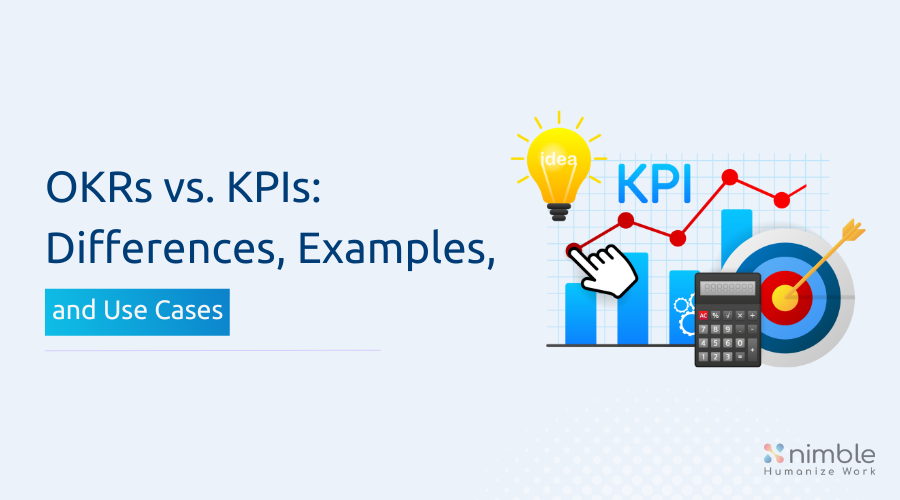OKRs vs. KPIs: Navigating the Metrics Maze – Differences, Examples, and Real-World Applications
Explore OKRs vs. KPIs: Uncover differences, examples, and real-world insights. Elevate your goal-setting and performance measurement strategies.

How can you ensure your organization reaches its goals if they aren’t clear? Also, how can you know whether you made any progress if you don’t track your objectives? The short answer is “you can’t”, for both questions.
That’s why goal-setting and objective tracking are paramount for organizations of all sizes. And when it comes to these two topics, two approaches stand above all of the rest: the OKR and KPI frameworks.
The troublesome thing is that individuals often mix OKRs and KPIs. Let’s make it clear: while both OKRs and KPIs can be effective approaches for the organizations that implement them correctly, they are still two different and separate frameworks.
In a nutshell, that’s the purpose of this post: to clear up the misconceptions between these two frameworks so that you, as a leader, can make an informed decision about which one is the best match for your organization.
Here’s a quick summary of the topics we’ll cover:
* OKR Benefits
* KPIs Fundamentals
* The Differences Between OKRs and KPIs
* OKR Examples and Use Cases
* Mention use cases of OKRs
* KPIs: Examples and Use Cases
Let’s dig in.
Let’s start by covering the benefits of OKRs. What’s the point behind using this approach?
The main benefits of OKR are clarity, alignment, and focus. OKRs, when correctly implemented, ensure people within an organization work together towards common goals. Transparency is another important word that comes to mind: OKRs communicate priorities, so everyone knows where they’re supposed to concentrate their efforts.
Yet another keyword when it comes to OKRs is engagement. Having clear, meaningful, and ambitious objectives that are communicated helps drive engagement. When folks in the organization see how these objectives link up with the big business goals and understand how they can personally contribute, it amps up the motivation.
After talking about the benefits of OKRs, let’s briefly cover the fundamentals of KPIs. First of all, what are KPIs?
KPI stands for Key Performance Indicator. As the name suggests, KPIs are metrics that assess how an individual or group performs at something that they deem important. In the case of an enterprise organization, the “something” is usually an aspect of the organization related to its business strategy.
After the “what” comes the “why”: why do people and groups use KPIs?
The main benefit of KPI is performance measurement. KPIs offer a quantifiable, objective way of assessing whether the organization is making real progress. This, in turn, enables data-driven decision-making, removing the guesswork from strategic decisions.
KPIs also help with prioritizing: by identifying and tracking the most important metrics, the organization ensures it’s putting its efforts where they pay off the most.
Finally, the complete set of KPIs can act as an alert system of sorts: by closely watching KPIs and reacting at the earliest signs that something is off, your organization can act ASAP when problems arise, before they reach catastrophic proportions.
The first difference between the OKR and KPI frameworks is that OKRs are meant to be highly inspirational while KPIs aren’t. We could argue that the main goal of OKR is to foster a cultural change, changing the behavior of individuals within the organization towards a better direction.
OKRs do that by setting meaningful, ambitious goals that are communicated clearly, creating alignment, focus, and engagement. KPIs, on the other hand, have goals that are much humbler, which is to measure and assess progress towards some specific measurement. They aren’t necessarily meant to motivate, inspire, or stretch employees beyond their limits.
Another major difference between the two approaches is their flexibility. OKRs are designed to be flexible and adaptable. KPIs, even though they can be adjusted, are meant to be a more stable set of measurements defined against some core business necessities.
Alignment is another area in which the two frameworks differ greatly. While you can use KPI measurements to create a sense of alignment inside your organization, alignment isn’t an explicit goal of the framework. When it comes to OKRs, the situation is different: fostering alignment within the department or company is an explicit objective of the framework.
Finally, let’s talk about scope. The scope of OKRs is naturally wider than that of KPIs. Since OKRs are supposed to engage and align the whole organization, it just makes sense that they should apply to everyone. KPIs can encompass several departments or the whole organization, sure, but it’s more common for them to be restricted.
Let’s now see some examples and use cases for OKRs
Objective: Increase User Satisfaction Through Enhanced Software Quality
Key Result #1: Reduce the number of critical bugs reported by 30% over the next quarter.
Key Result #2: Deliver at least two major features requested by our customers with a high satisfaction rating.
Key Result #3: Reduce major system outages to zero over the next six months.
As you can see, the objective here relates to software quality. It’s practical yet aspirational and doesn’t carry details. The key results, on the other hand, are specific and quantifiable. They are ambitious but relevant; they’re connected both to the objective and to each other.
The use case for the OKR above is all about increasing the quality of the main product. Let’s see a different example, belonging to the use case of employee development:
Objective: Improve employee skills and satisfaction.
Key Result #1: Achieve a 30% increase in attendance for employee training sessions.
Key Result #2: Achieve at least 80% employee satisfaction rate on GlassDoor.
Key Result #3: Create a mentorship program with a participation rate of 90%.
Let’s now turn our attention to KPI examples. A common use case within an organization is customer satisfaction, and a classical KPI to track that is NPS (net promoter score).
Within the use case of incident management, there are several famous and valuable KPIs, such as MTTR (Mean Time To Repair), MTBF (Mean Time Between Failures), and MTTF (Mean Time To Failure).
KPIs are also abundant in the realm of software development. Some important KPIs here are cycle time, lead time, velocity, test coverage, and release burndown.
If I accomplished my mission in this post, by now you should understand that the “OKRs vs KPIs” question doesn’t make much sense. These two approaches aren’t competitors, since they attach very different angles on the whole “goal-setting/progress-measurement” thing. They are aimed at different goals and, as such, don’t compete but rather complement each other.
We can say that OKRs and KPIs work together nicely when implemented correctly, each one in its lane, without stepping on the other’s toes. Think of OKRs as a more high-level approach: it’s inspirational, strategic, broader in scope, more durable but also more flexible. Think of KPIs as more tactical, “on the ground”, and concerned with day-to-day activities and measurements. They aren’t supposed to be inspirational, but rather to get the mundane work done of tracking and reporting on important datapoints that makes decision-making easier and more educated.
Nimble introduces a powerful dimension to the realm of OKRs, streamlining the process of goal management. With Nimble OKR’s intuitive interface, setting and tracking OKR goals becomes a seamless experience. Collaborative features enable teams to align objectives, track progress in real-time, and adapt strategies dynamically. Whether you’re aiming for ambitious targets or fostering team cohesion, Nimble OKR management empowers you to navigate your objectives with precision and agility. Unlock the full potential of your goals with Nimble’s comprehensive OKR management capabilities.

OKRs 101
OKRs vs. KPIs: Navigating the Metrics Maze – Differences, Examples, and Real-World Applications
Explore OKRs vs. KPIs: Uncover differences, examples, and real-world insights. Elevate your goal-setting and performance measurement strategies.
What is an OKR goal? What is an OKR objective?
Implementing OKRs can be a great way for organizations to create organization-wide goals that keep motivation and alignment high, and in this post, you’ll learn more about this framework.
Tracking OKRs: Where the Real OKR Magic Happens
Implementing OKRs: 11 Do’s and 8 Don’ts for OKR Success
OKR Implementation Guide: 8 Tips to Ace Your OKRs
OKR Targets and Psychological Safety: At Odds or a Match Made in Heaven
SMART Goals or OKRs Targets for Motivational Power?
Join 150,000+ Pioneers, Leaders & Mavericks receiving our updates!

